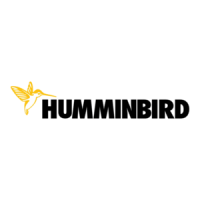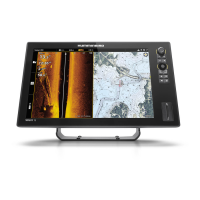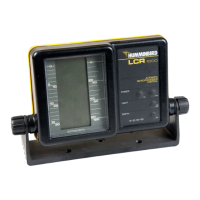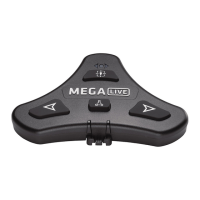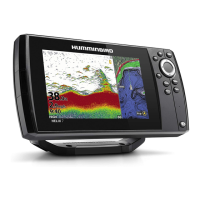Do you have a question about the Humminbird SOLIX series and is the answer not in the manual?
Download and use Humminbird manuals on mobile devices or computers for reference.
Explains the functions and operations of each key on the SOLIX control head keypad.
Details touch screen actions, gestures, and tap functions for navigating the SOLIX interface.
Procedures for powering on the SOLIX control head and selecting operational modes.
Instructions on how to properly power off the SOLIX control head.
How to check GPS reception, satellite status, and signal strength using the GPS tool.
Verifies that connected sensors are detected and communicating with the control head.
Steps to pair a mobile device with the SOLIX control head using Bluetooth wireless technology.
Guide on configuring and setting various system and application alarms for alerts.
Instructions on opening tools, widgets, and navigating the SOLIX main Home Screen interface.
Description of various tools available on the Home Screen for managing data and device settings.
How to access the main menu settings for the control head via the Settings tool.
Steps to open and use context-sensitive X-Press menus for various views and operations.
How to access and display available views from the SOLIX Views tool for data visualization.
Customizing the on-screen view's appearance, preferences, and data overlays for personalized display.
Information on supported chart sources like Humminbird, Navionics, and AutoChart Live for map display.
How to use Humminbird and Navionics built-in charts and customize their display settings.
How to start recording sonar data to create custom depth maps with AutoChart LIVE.
Modifying map display settings like depth range, contour interval, and color palette for AutoChart Live.
Steps to record, display, and save Side Imaging or 360 Imaging data as a Mosaic for detailed imaging.
How the control head communicates navigation data to the Humminbird autopilot system for automated steering.
Instructions for starting, stopping, and configuring radar transmission modes for optimal operation.
Fine-tuning radar signal settings like gain, sea clutter, and rain clutter for clearer returns.
Details on MEGA Imaging+ sonar, including transducers and frequency options for enhanced imaging.
Customizing the 2D Sonar View with modes, zoom, sensitivity, and display settings for better fish detection.
Customizing Side Imaging View preferences like beams, color palette, and contour mode for detailed analysis.
Customizing Down Imaging View preferences like palette, zoom mode, and bottom line for improved clarity.
Procedures for starting sonar recordings, selecting beams, and specifying save locations for analysis.
Using the snapshot feature to capture on-screen views and optionally mark waypoints for reference.
Advanced settings for enabling transducer functionality and configuring options for optimal sonar performance.
Recommended procedures for configuring Humminbird radar after installation or repair for optimal performance.
Using Auto Tune or Manual Tune to optimize radar system settings for clearer target returns.
Steps to configure a new Humminbird network and synchronize control head settings across devices.
Assigning transducers as sonar sources to each control head in the network for data sharing and optimal performance.
Selecting primary and secondary GPS sources automatically or manually for accurate positioning.
Adjusting backlight and night mode settings for optimal screen visibility under various conditions.
Instructions for importing and exporting menu settings and navigation data for backup or transfer.
Exporting navigation data and menu settings to an SD card before software updates or system resets.
Steps for automatically updating the control head and accessory software via SD card for the latest features.
Technical specifications for the SOLIX 2D G1 control head and CHIRP DualBeam PLUS transducer.
Download and use Humminbird manuals on mobile devices or computers for reference.
Explains the functions and operations of each key on the SOLIX control head keypad.
Details touch screen actions, gestures, and tap functions for navigating the SOLIX interface.
Procedures for powering on the SOLIX control head and selecting operational modes.
Instructions on how to properly power off the SOLIX control head.
How to check GPS reception, satellite status, and signal strength using the GPS tool.
Verifies that connected sensors are detected and communicating with the control head.
Steps to pair a mobile device with the SOLIX control head using Bluetooth wireless technology.
Guide on configuring and setting various system and application alarms for alerts.
Instructions on opening tools, widgets, and navigating the SOLIX main Home Screen interface.
Description of various tools available on the Home Screen for managing data and device settings.
How to access the main menu settings for the control head via the Settings tool.
Steps to open and use context-sensitive X-Press menus for various views and operations.
How to access and display available views from the SOLIX Views tool for data visualization.
Customizing the on-screen view's appearance, preferences, and data overlays for personalized display.
Information on supported chart sources like Humminbird, Navionics, and AutoChart Live for map display.
How to use Humminbird and Navionics built-in charts and customize their display settings.
How to start recording sonar data to create custom depth maps with AutoChart LIVE.
Modifying map display settings like depth range, contour interval, and color palette for AutoChart Live.
Steps to record, display, and save Side Imaging or 360 Imaging data as a Mosaic for detailed imaging.
How the control head communicates navigation data to the Humminbird autopilot system for automated steering.
Instructions for starting, stopping, and configuring radar transmission modes for optimal operation.
Fine-tuning radar signal settings like gain, sea clutter, and rain clutter for clearer returns.
Details on MEGA Imaging+ sonar, including transducers and frequency options for enhanced imaging.
Customizing the 2D Sonar View with modes, zoom, sensitivity, and display settings for better fish detection.
Customizing Side Imaging View preferences like beams, color palette, and contour mode for detailed analysis.
Customizing Down Imaging View preferences like palette, zoom mode, and bottom line for improved clarity.
Procedures for starting sonar recordings, selecting beams, and specifying save locations for analysis.
Using the snapshot feature to capture on-screen views and optionally mark waypoints for reference.
Advanced settings for enabling transducer functionality and configuring options for optimal sonar performance.
Recommended procedures for configuring Humminbird radar after installation or repair for optimal performance.
Using Auto Tune or Manual Tune to optimize radar system settings for clearer target returns.
Steps to configure a new Humminbird network and synchronize control head settings across devices.
Assigning transducers as sonar sources to each control head in the network for data sharing and optimal performance.
Selecting primary and secondary GPS sources automatically or manually for accurate positioning.
Adjusting backlight and night mode settings for optimal screen visibility under various conditions.
Instructions for importing and exporting menu settings and navigation data for backup or transfer.
Exporting navigation data and menu settings to an SD card before software updates or system resets.
Steps for automatically updating the control head and accessory software via SD card for the latest features.
Technical specifications for the SOLIX 2D G1 control head and CHIRP DualBeam PLUS transducer.
| Depth-Sonar Standard | Up to 1, 500 feet (varies by model) |
|---|---|
| Interface | Touchscreen |
| GPS | Yes |
| Cartography | Humminbird Basemap |
| Target Separation | 2.5 inches |
| Networking | Ethernet, NMEA 2000 |
| Memory Card Slot | Yes |
| Waterproof | IPX7 |
| Operating Frequency | 1.2MHz |
| Dimensions | Varies by model |
| Weight | Varies by model |
| Display Size | 10.1", 12.1" |
| Display Resolution | 1280 x 800 pixels (varies by model) |
| Operating Temperature | -15°C to 55°C (5°F to 131°F) |
